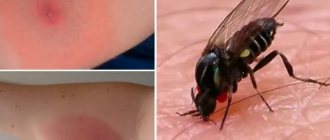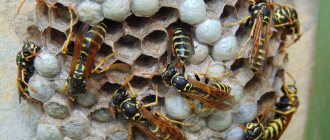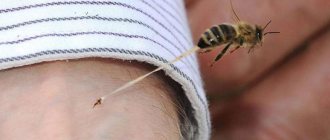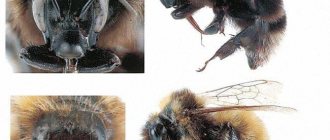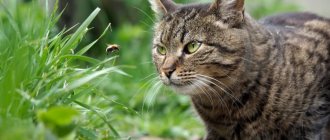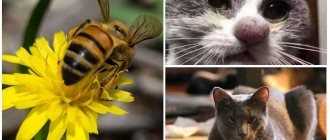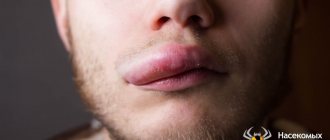The bee is a hardworking and beautiful insect. It doesn’t waste a minute, buzzes, flies from flower to flower, collecting pollen, and can easily attract the attention of adults and children.
But do not rush to touch it - in defense, this insect stings. Its bite can be dangerous to health: older people, children and people with allergies can suffer more harm.
Let's take a closer look at the reasons why it stings and what to do at home if you are bitten by a bee.
Bite symptoms
- Instant, sharp pain (often with a throbbing burning sensation), concentrated mainly at the site of the bite.
- A protruding black sting in a tiny bag of poison.
- Localized redness appears (no more than 10 cm in diameter), and after half an hour severe itching appears.
- The area of skin or the entire affected area becomes very swollen, with peak swelling occurring within 48-72 hours.
- Swelling of the stung area. For allergy sufferers, symptoms can worsen greatly, as swelling of the mucous membranes, breathing problems, and changes in heart rate may appear.
Bees, wasps and hornets
These bites can be classified as protective; no one bites you on purpose - it is a defensive reaction to aggression or defense of territory. These stinging bites are dangerous because they contain poison. They are painful and do not go away unnoticed. They may cause extensive swelling, fever and general intoxication of the body. In multiple cases, the outcome is often fatal. Learn more about what to do if you are bitten by a wasp or hornet.
Providing first aid for a bee sting
- It’s good to examine the site of the bite; it looks like a bright pink papule with a bee sting in the middle. If you do not observe it, then most likely it has gone deeper into the wound; it may also be that you were bitten by a wasp, and it does not leave a sting in the victim.
- The sting should be removed from the skin. If you have slightly overgrown nails, you can remove them, but preferably with tweezers. If the sting remains in the skin, it must be squeezed out; you must squeeze until you see drops of blood, in which case some of the poison will come out.
- You should go over the bite site with a cotton pad that has been previously moistened with an antiseptic. Any remedy will do - chlorhexidine, hydrogen peroxide, iodine or brilliant green.
- Next you need to apply cold. You can use frozen meat from the freezer, but first you need to wrap it in a clean cotton towel.
- It is important to treat the stung area of skin with a local antihistamine, this can be Fenistil in the form of a gel or Psilo-balm.
- You should also be sure to take an antihistamine. This measure of necessary assistance, especially if an overly active reaction of the body occurs (rash, huge swelling, suffocation, etc.), including if the victim is prone to allergies, as well as in children under 12 years of age.
We advise giving a person stung by a bee plenty of fluids - water, sweet tea, compote. This is done in order to reduce the concentration of poison in the human body and speed up its elimination.
Note! If a bee has bitten you in the eye, then you cannot do without an ambulance; you must first complete the entire first aid algorithm.
First aid
The first thing to do after a bite is to pull out the sting ! By hand or with tweezers - it doesn’t matter, the main thing is to do it as early as possible. The longer the sting remains in the skin, the more poison will enter the epithelium and blood. However, you should be extremely careful, since a bag of poison remains along with the sting. Carefully remove the sting with the bag without pressing on it. If you have tweezers on hand (there are always eyebrow tweezers in a woman's purse), use them.
Wasp sting (macro)
First aid for a bee sting at home:
- Remove the sting with tweezers or your fingers, carefully pulling it out of the wound.
- Apply something cold: ice, a clean, wet cloth, or a bottle of water. Cold will help “calm” the wound and stop the development of swelling.
- The next stage is disinfection. You can use an alcohol-based antiseptic, peroxide or iodine solution.
- If you have some kind of anti-allergic remedy in your home medicine cabinet, great. Hydrocortisone ointment (1%) (pharmacy names: “Cortade” , “Lokoid” , “Hydrocort” and others), “Psilo-balm” or is suitable . Apply the bite area according to the instructions.
- To be sure, you can take an antihistamine tablet to prevent an allergic reaction.
Healthy! To understand how the body reacts to a bee sting, drink water, tea or compote. At least 300 ml. If the general condition does not worsen within 20-30 minutes, then there is no allergy.
If a bee stings you in nature, far from home and a home medicine cabinet, you can use the following to disinfect and relieve pain:
- a bottle of cold water;
- saline or soda solution;
- soap;
- olive oil;
- a piece of raw potato;
- You can also anoint the bite site with the juice of plantain, parsley or onion.
Consequences of a bee sting (allergies)
What to do if a child is bitten by a bee
With young children (under 10 years old), it is important to be more careful, as a bite can turn into an allergy to bee venom. The harmful effects of a bite are also due to the fact that a child’s body weight is much smaller than an adult’s, so the toxic effect of the poison is more pronounced.
If the bite is located near the mouth, throat or eyes, you should immediately call an ambulance. It is recommended to remove the sting from the baby's skin as soon as possible.
If a child is bitten by a bee on a limb, arm or leg, then the consequences are much simpler, so you can stop the consequences yourself.
What to do if a bee stings your hand?
- First of all, you need to give your child plenty of drink (teas, compotes or juices).
- Remove the sting. And reduce the rate of spread of poison throughout the body by contacting the stung area with cold.
- It is important to explain to the child that it is forbidden to scratch the bitten area. If the baby is still very small, then you will have to make sure that he does not scratch.
- It is necessary to give antihistamines in the dosage recommended by the manufacturer (Tavigil or Suprostin), cream or ointment, for example, Finistil.
How to remove a tumor if bitten by a bee, folk remedies:
- Plantain leaf.
- A piece of onion, garlic.
- Soda with water.
Bee venom: its components and their properties on humans
Bee venom or, as it is also called, apitoxin is produced by worker bees. It is a thick transparent liquid with a slight odor of honey and a bitter taste. Apitoxin has a very complex composition and has a strong active effect. The poison contains not only proteins and amino acids, but also fat-like and mineral substances. It consists of 50% water.
The main dry element of apitoxin is melitin and other toxic polypeptides, which, interacting with organic acids, magnesium and proteins with enzymatic properties (phospholipase A2, hyaluronidase, acid phosphatase) make it therapeutic. Hyaluronidase, for example, promotes the rapid spread of apitoxin, and phospholipase A2 reduces blood clotting. But histamine, which is part of apitoxin, causes swelling of the tissue in the bitten area and is the main cause of anaphylactic shock, but at the same time, thanks to it, apitoxin helps reduce blood pressure and dilates blood vessels.
Bee venom contains the following amino acids:
- alanine;
- isoleucine;
- arginine;
- cystine;
- glycine;
- tryptophan.
Also, minerals such as manganese, sulfur, phosphorus, iodine and others were found in it. The sting causes a strong burning sensation due to the acids (formic, phosphoric, hydrochloric) included in its composition. The effect of poison on a person depends not only on its amount entering the blood, but also on the place of penetration and individual intolerance.
How to help a dog stung by a bee
The first step is to understand where the bee bit the dog, then disinfect the tweezers and remove the sting.
Then perform the following actions:
- Gently wash the bite area with clean distilled water or baby soap. Only in this case it is important to try not to make soap into the wound itself.
- Give the injured pet an antihistamine; it can be bought at a veterinary pharmacy, but some dog breeders say that human antihistamines can also be given.
- The wound from which you removed the insect sting should be poured with hydrogen peroxide, and excess peroxide should be absorbed with paper towels.
- Next, the punk needs to be anointed with anti-itching ointment, for example, Tavegil.
- Then apply a cold compress to the stung area of skin for 20 minutes, with short breaks, so that the cold does not freeze the dog too much.
- If swelling is severe, it is appropriate to give your dog a diuretic (such as Lasix or Ugeril).
- It is advisable to lighten the dog’s diet for 3-4 days and replace the usual diet with lighter foods. This is necessary so that the body fights the poison, and does not waste energy on digesting heavy food.
- It is important to provide your dog with constant access to clean drinking water.
This algorithm of action can also be applied if a bee has bitten a cat.
Important! Try to closely monitor the condition and health of your pet for the first 24 hours after the bite. If alarming symptoms appear: hoarse breathing, cough, rash or severe swelling, then you should immediately take your dog to a veterinary clinic for qualified assistance.
What to do at home
What to do if you are bitten by a bee and how to prevent the spread of poison? First you need to calm down. The main thing is not to panic and strictly follow the recommendations. But what to do if you are stung by a bee at home if you don’t have the necessary medications nearby? Folk remedies will help:
- a water-based solution of aspirin and activated carbon tablets;
- baking soda;
- plantain leaves;
- onion gruel;
- olive oil;
- succulent aloe vera leaves;
- infusion of lemon balm, mint;
- grated potatoes and parsley root.
First aid
First aid for a bee sting:
- Remove the sting to prevent the spread of toxic substances. Treat the instrument with pure or diluted alcohol. It is not convenient to remove it with your fingers; on the contrary, you can deepen the sting or cause an infection.
- Treat the stung area with a disinfectant. Apply ice.
- Drink weak tea, juice, water, replenishing fluid in the body.
- Be sure to take anti-allergy medication. Allergy sufferers are advised to have a syringe and the necessary medicine, as well as a passport with a type of typical immunological process.
- If an acute reaction occurs, call emergency help. Try to lower your blood pressure.
- Emergency assistance consists of restoring breathing and starting the heart.
How to treat a wound
Complex-action drugs that reduce symptoms and are aimed at treatment are suitable for treating wounds. Disinfect with vodka, hydrogen peroxide, and a weak solution of manganese. The remedies will reduce discomfort and help remove swelling. Apply cold.
Folk remedies and recipes
If you are stung by a bee, you can always use effective folk remedies that are always at hand:
- Baking soda gruel provides relief within ten to fifteen minutes.
- A decoction of parsley sprigs quickly removes swelling. Three teaspoons of raw material per two hundred milliliters of warm water. Apply lotions to the affected area.
- Compresses with onion juice help draw out bee venom and prevent suppuration.
- Lotions made from grated raw potatoes relieve puffiness from the face.
- Table vinegar or sour berries and fruits can serve as an antidote. Just lubricate the sore spot with a cotton pad.
Activated charcoal and aspirin
It doesn’t matter if you don’t have antihistamines on hand. Knowledge of the properties of plants and skillful use of available means will help eliminate the consequences of bee stings. Activated carbon is an excellent adsorbent for various poisons. In combination with aspirin, an activated carbon tablet eliminates pain. You can make a similar mixture by simply dissolving the tablets in a glass of water. Then moisten a cotton pad and apply it to the bite site.
Parsley
Parsley grows in literally every garden bed, and is always at hand in the kitchen of housewives. The plant has long established itself as a natural healer. Few people know that it has an excellent anti-inflammatory effect. As soon as you apply parsley leaves, previously crushed or poured with boiling water (the cell walls are destroyed and the active substances come out), the redness disappears and the pain goes away.
Plantain leaves
Plantain leaves have less effect. It is recommended to use them together with parsley. Instead of a cotton pad, parsley decoction is applied to the plantain. The juice of this plant has long been known in medicine and helps speed up wound healing.
In folk medicine, a compress of plantain and yarrow leaves is often used for bee stings. Both plants are crushed and made into a decoction. A little paste is placed on a gauze bandage. The compress is changed every 2 hours. Thanks to their bactericidal and anti-inflammatory properties, these plants perfectly tone the skin and relieve any irritation.
Birch leaf
Birch leaves contain components that relieve inflammation and irritation on the skin. The leaf also needs to be crushed a little, when it becomes damp, applied to the tumor for an hour or two, then replace the leaf with a fresh one.
Series
Grass is a weed. It grows where there is moisture: near rivers, lakes, swamps. Found in many regions of our region. How to quickly remove swelling using a series: pick a few leaves, grind them or crush them in a mortar and apply the paste to the sore spot for 3-4 hours.
Herbal compresses
Herbs such as chamomile, calendula, St. John's wort, yarrow, and sage can relieve swelling, tumors, and dermatitis. You can take any herb or a mixture of several, brew a strong infusion and make lotions to reduce unpleasant symptoms. A cotton or gauze swab is soaked in the infusion and applied to the bite for several hours.
Herbal compresses will help relieve swelling
Olive oil
Chilled olive oil also relieves irritation and redness at the bite site. The presence of unsaturated fatty acids has a beneficial effect on the skin, producing a nourishing and regenerating effect. It is enough to apply small portions of oil to the damaged area several times for its healing qualities to manifest themselves.
Onion
Despite the not very pleasant smell, onions have long been used to eliminate the consequences of bee stings. The juice of the onion contains a number of substances that actively bind the components of the poison. The bactericidal properties of onions reduce the risk of infection. The slight burning sensation caused by the onion juice compensates for the pain. Within a few minutes, the redness goes away and the swelling noticeably decreases. Onions are used both in crushed form (gruel) and almost whole (cut in half), the main thing is the intensive release of medicinal juice.
Mud method
Immediately after the bite, a mud application helps a lot. A small amount of mud is mixed with water and applied to the wound. After 15 minutes, the surface is thoroughly washed.
Interesting! The method is suitable for reducing pain, however, the procedure cannot be repeated constantly so as not to introduce bacteria into the wound.
Tobacco
Tobacco will help numb the bite site and relieve swelling. The substance is lightly chewed and then applied to the wound. The action can be repeated several times.
Honey
Using honey for a bee sting promotes rapid healing. Using a folk remedy is simple - apply a small amount to the damaged area and cover with a clean bandage. Keeping the compress is allowed for an hour. If necessary, repeat the procedure.
Aloe
Even 3 thousand years ago, the medicinal properties of aloe were mentioned. Now this plant is widespread throughout the world and can be easily grown at home. It’s not for nothing that they say about aloe: a home first aid kit. Aloe juice is used in a not too concentrated form, after diluting it with water.
Not only compresses with juice are applied to the bite sites, but also whole leaves. The skin is first removed from them, thereby stimulating the release of biologically active substances. After using aloe, swelling decreases, itching and hives go away. The skin is noticeably healthier, the bite heals faster.
Consequences of a bee sting
For many people, the swelling and swelling subsides within 2-.5 hours - the most important thing here is not to scratch the damaged area. But for about 1 percent of people, bee stings cause dangerous consequences.
Anaphylaxis is a dangerous allergic reaction that threatens the life of the victim. Its symptoms are as follows:
- The neck and larynx swell terribly;
- Breathing becomes difficult - it noticeably quickens, it is difficult to breathe, sometimes even wheezing appears;
- Blood pressure drops rapidly, and the pulse becomes threadlike;
- Dizziness, signs of nausea may appear;
- The victim loses consciousness.
If anaphylactic juice appears, then you need to immediately call an ambulance, since it will not be possible to cope without experienced doctors.
Complications and prognosis after a bite
The most common consequence of an insect or animal attack is swelling of the respiratory system. It appears in 2-5% of victims. Edema is controlled by intramuscular injection of glucocorticosteroids. In the absence of timely assistance, pulmonary edema leads to death.
In 0.5% of cases, after a bite, anaphylactic shock is observed - a severe allergic reaction of the body to toxins and poisons. Mortality from anaphylactic shock is high - 25% with timely assistance and 50% without treatment.
Severe consequences occur in patients after multiple bites, for example, multiple organ failure. The disease provokes accelerated death of red blood cells. Remains of cells settle in the kidney and liver tubules, complicating the functioning of internal organs. If one organ is affected, mortality occurs in 20% of cases, two or more - in 60% of cases.
How to Avoid a Bee Sting
To avoid becoming a victim of a bee, you should follow some rules:
- Eat sweets and fruits carefully and attentively, especially in nature.
- If you are going on vacation in the fresh air, choose neutral colors of clothing.
- A hat and clothing covering arms and legs protects against suspected bites.
- You should not smell of perfume, deodorant, cigarettes, alcohol or gasoline, as these odors greatly anger the bees.
- You should be especially careful when walking in open shoes when meadows and herbs are in bloom.
- The bees' anger only intensifies with sharp swings of their hands, so if the bee had no intention of stinging you before, then your swings may change its mind. This recommendation applies to all flying and biting insects.
- There is no need to disturb the hive and approach them less than 3 meters.
- You need to treat yourself with products that will repel insects.
- When caring for an apiary, it is important to use protective equipment.
We hope you found this article helpful. Remember that if a severe allergic reaction is observed after a bite, you should immediately call an ambulance. All the best!
Useful tips
- Bees are attracted to sweet smells. When going for a walk in nature, try not to use perfume with the aroma of flowers and sweet notes.
- If an insect flies close or lands on clothing, there is no need to make sudden movements. The bee is not aggressive and will calmly leave you soon if you do not start waving your arms, screaming and fussing.
- When walking in the forest, wear closed shoes and trousers. Bees may be found in low-growing flower bushes.
- The victim of a bite is advised to drink more, water will quickly remove toxins from the body.
- Diuretic herbs also reduce swelling.
- When dining outdoors, it is advisable to clean up after yourself as soon as possible. The smell of certain foods attracts many stinging insects.
- You should stay away from bee apiaries. You should not approach them out of curiosity without special protective equipment.
- Sun rays intensify skin reactions. It is advisable to protect the bite site from ultraviolet radiation.
- A person who has been bitten should not drink alcohol under any circumstances; this will enhance the effect of the poison and can cause the most severe consequences.
- Install protective nets on windows in the summer.
A bee sting is an unpleasant and sometimes dangerous thing. If allergic symptoms increase, you should immediately call an ambulance or take the victim to the hospital yourself.
Sources
- https://upchel.ru/pchelovodstvo/pomoshh-ukuse
- https://parazitdoma.ru/sovety/uksus-pchely-chto-delat-kogda-vas-uzhe-ukusili-pervaya-pomosch-preparaty-i-domashnie-sredstva-i-chto-delat-kategoricheski-nelzya
- https://www.ayzdorov.ru/lechenie_ykys_pcheli.php
- https://bolezni-kozhi.ru/kak-snyat-otek-ot-ukusa-pchely.html
- https://GdeKlop.ru/osy-i-pchely/pravila-pervoj-pomoshhi/
- https://www.neboleem.net/pervaja-pomoshh-pri-ukuse-pchely.php
- https://pchela-info.ru/pchely/pervaya-pomoshh-pri-ukusah
- https://www.polismed.com/articles-ukus-pchely-osy-chto-delat.html
- https://plannt.ru/otek-posle-ukusa-osy-ili-pchely
- https://7ogorod.ru/prochee/ukusila-pcela-snat-opuhol.html
[collapse]
Photos of bee stings
Types of blood-sucking and stinging insects
Many insects bite and sting, but few do it intentionally. Most bites are relatively harmless, leaving only an itchy patch of skin.
But some insects can be carriers of serious diseases, and then the bites pose a danger to humans.
Insects that bite intentionally:
- mites;
- bedbugs;
- fleas;
- lice;
- midges;
- mosquitoes.
Many large insects will not specifically seek out prey to sting, but will bite if they feel threatened. Usually the sting of a bee or ant contains poison. When it is injected into the skin, a sensation of itching and pain occurs.
Stinging insects:
- bees;
- hornets;
- wasps;
- red forest ants.
What Causes a Sting Reaction?
The venom introduced into the body through a bite engages the body's immune system. Often the immediate reaction includes redness and swelling of the affected area, followed later by itching and soreness.
If a child is very sensitive to insect venom, bites can cause anaphylactic shock: constriction of the throat and difficulty breathing.
